 |
| Central Press/Hulton Archive/Getty Images |
Our flashback to royal-royal state visits from decades past continues today with a closer look at the jewels worn during the Belgian state visit to London in May 1963.
 |
| The Queen leads a royal contingent at the wedding of Princess Alexandra, April 1963; with her are the Duke of Edinburgh and the Prince of Wales, followed by the Queen Mother, King Olav V of Norway, Queen Friederike of the Hellenes, Queen Louise of Sweden, Queen Ingrid of Denmark, and Princess Anne-Marie of Denmark (Keystone/Hulton Archive/Getty Images) |
In the spring of 1963, Queen Elizabeth II was 37 years old and preparing to celebrate the 10th anniversary of her coronation. Eleven years after becoming monarch, she was praised in the press for commanding near universal respect in her role. She had recently returned from an extensive royal tour of New Zealand and Australia. She was also part of a busy and growing family. Married for 15 years to the Duke of Edinburgh, she had three children: Prince Charles (14), Princess Anne (12), and Prince Andrew (3). The following year, the family welcomed their sixth and final member, Prince Edward. The extended Windsors were also busy with family events. Most recently, in April 1963, Princess Alexandra had married Angus Ogilvy in a glittering ceremony at Westminster Abbey.
 |
| Queen Fabiola of the Belgians, 1963 (AFP via Getty Images) |
Across the channel in Brussels, King Baudouin of the Belgians was nearing the 12th anniversary of his accession to the throne, which happened following the abdication of his father, King Leopold III. Baudouin inherited a shaky throne, and his own reign was sometimes marked by turmoil, including his handling of the independence of the Democratic Republic of the Congo in the early 1960s. The 32-year-old king had married a Spanish aristocrat, Fabiola Mora y Aragon, in a lavish wedding in December 1960. Though the couple desperately wanted children, they were not successful in producing an heir. Fabiola, who turned 35 a few weeks after this state visit, had suffered miscarriages in 1961 and 1962; a third happened in the autumn of 1963. But although they were never able to start the family they so wished for, their marriage was reportedly particularly strong, with the press praising the way they worked together as a team.
Expectations for the Belgian state visit to Britain were high in May 1963. The last Belgian monarch to make a state visit to London had been King Baudouin’s father, King Leopold III, in 1937. Leopold had significant family ties to the British royals; he was the great-grandson of King Leopold I, who was the uncle of both Prince Albert and Queen Victoria, and the widower of Princess Charlotte of Wales. But Leopold III’s attempted neutrality at the outbreak of World War II had caused strains both at home and abroad. One Scottish newspaper reported that many Belgians looked at the 1963 state visit as “an opportunity to melt the coolness between the two royal houses” that lingered after the end of the war.
King Baudouin and Queen Fabiola flew from Belgium to London to begin the visit, touching down at Gatwick Airport on Tuesday, May 14. They were officially welcomed by Princess Margaret and the Earl of Snowdon, who boarded the plane to escort the royal couple to British soil. The Belfast Telegraph reported that, as Queen Fabiola stepped off the plane, her “smile and warmth immediately communicated itself” to those waiting to greet her. King Baudouin inspected Royal Air Force servicemen on the tarmac before the royal party proceeded to the train that would take them into London.
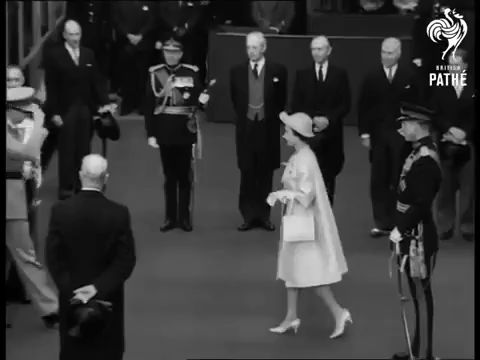
When the train pulled in to platform two at Victoria Station, several members of the British royal family and the British government were waiting to greet the Belgian royals. Queen Elizabeth II greeted King Baudouin with a handshake, and he reciprocated with a kiss on the cheek.

Both the Queen and the Duke of Edinburgh also greeted Queen Fabiola, who wore, according to press reports, “a very light stone-colored coat and a brown hat.” You’ll also note Prime Minister Harold Macmillan standing off to the side.

Along with Princess Margaret and Lord Snowdon, who had traveled with the Belgian royals on the train, Baudouin and Fabiola were also met at the station by the Princess Royal and the Duke and Duchess of Gloucester.
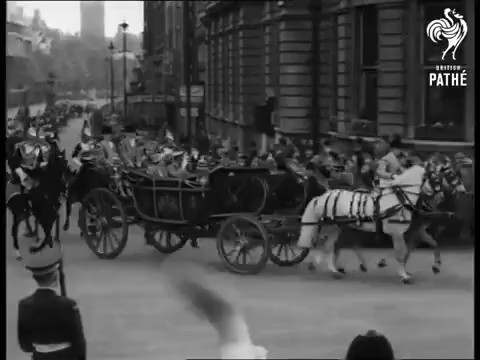
A carriage procession brought the royal party from Victoria Station to Buckingham Palace, with waving crowds lining the streets as they passed by Trafalgar Square.
 |
| Central Press/Hulton Archive/Getty Images |
Baudouin and Fabiola stayed at Buckingham Palace during this four-day state visit. (Appropriately, they were assigned the Belgian Suite, which was named for Baudouin’s great-great-grandfather, King Leopold I.) On arriving at the palace, both royal couples posed for an official photograph after stepping out of their carriages. The carriage ride was a rainy one — can you tell by looking at Baudouin’s uniform?
 |
| Central Press/Hulton Archive/Getty Images |
The portrait gives us an excellent look at the Queen’s brooch choice for the official welcome: the Cambridge Emerald Scroll Brooch, which originally came from the lower portion of the stomacher from the Delhi Durbar Parure. According to press reports, the Queen’s coat was “peppermint green.”

After a quick outfit change, the Belgian couple headed to Westminster Abbey, where they laid a wreath at the Tomb of the Unknown Warrior.
After leaving the Abbey, the couple headed to Clarence House, where they were hosted for tea by the Queen Mother. The afternoon also included meetings with city council dignitaries at St. James’s Palace.
Tuesday evening was the night of the grand state banquet at Buckingham Palace. Unfortunately, because cameras were not allowed inside the event and the guests were staying at the palace, we have almost no images from the dinner. Above, you’ll see the Duchess of Gloucester arriving for the event wearing the Teck Turquoises. A news report from the Chicago Tribune offers us a description of the Queen’s attire for the banquet: “”white satin embroidered with gold and pearls,” plus the bright purple sash of the Order of Leopold. (On a related chivalric note: she made Baudouin a Knight of the Garter just before the banquet.) The Guardian reported that she wore “a pearl and diamond tiara” — so I’d wager that she chose the Vladimir Tiara for the dinner. The same paper described Queen Fabiola’s attire as “a dress of white satin entirely embroidered with pearls and other coloured stones, with a diamond tiara.” Given the importance of the occasion, I’d guess that the tiara in question is the Nine Provinces Tiara, though we know that she also had the Wolfers Tiara in her luggage.
We do know a little of what the Queen said during the speeches at the dinner. According to press reports, she declared, “The world is changing and developing, and Europe can no longer afford the conflicts and jealousies which have marked so much of its history. However, the existence of the European family is not a negative thing, to be admitted reluctantly and under pressure, but a thing to be proud of, a source of strength and vitality.”

The second day of the Belgian couple’s state visit, on Wednesday, May 15, found them in a slightly unusual place: on the River Thames. After attending morning mass at Westminster Cathedral, they boarded a barge, the Royal Nore, which took them to the City of London. They visited the Tower of London before traveling to the Guildhall for a banquet luncheon. The choice of water transportation was partly to impress the guests — and partly to help avoid disruptions of morning traffic!

Around 650 guests were in attendance at the lavish luncheon. Baudouin and Fabiola were escorted by Princess Margaret (wearing the same yellow outfit and hat she’d worn a few weeks earlier for Princess Alexandra’s wedding) and Lord Snowdon. During the luncheon, the Lord Mayor, Sir Ralph Perring, made a lengthy speech linking British and Belgian history. He noted, “The art of self-government was learned by experiment in municipal affairs. If we in the City of London may boast of having taught its principles to our friends up-stream at Westminster, we must acknowledge that we ourselves learned it very largely from the civic pioneers in Flanders. If England is the Mother of Parliaments, then Belgium must be the Grandmother.”

That evening, following a dinner party given by Queen Elizabeth and Prince Philip at Buckingham Palace, the royals set off for the Royal Opera House in Covent Garden. There, they attended a gala performance hosted by the British government in the Belgian royal couple’s honor.
 |
| Ted West/Central Press/Getty Images |
Queen Fabiola dazzled in jewels for the performance, wearing the Nine Provinces Tiara, the Wolfers Necklace, and her diamond and ruby bracelet. The Daily Herald described her ensemble as a “matching coat and dress of pale grey” which were “turned into sparkling silver by encrusted glittering stones.”
Queen Elizabeth II was radiant in a shimming gown, accessorized with Queen Alexandra’s Kokoshnik, the Coronation Necklace and Earrings, and Queen Mary’s Lover’s Knot Brooch.
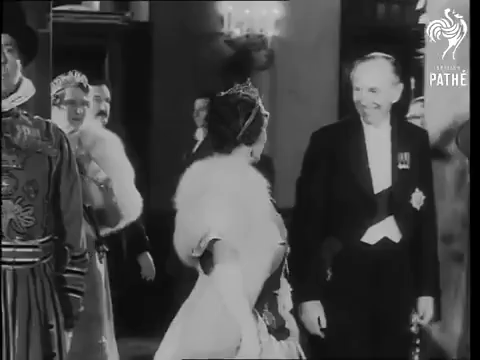
The royal box was full for the occasion, with around 25 guests in attendance. Among these were the Queen Mother, who wore the Greville Tiara for the performance with the Greville Emerald Necklace and Earrings.
Here’s a color view of her jewels and outfit.
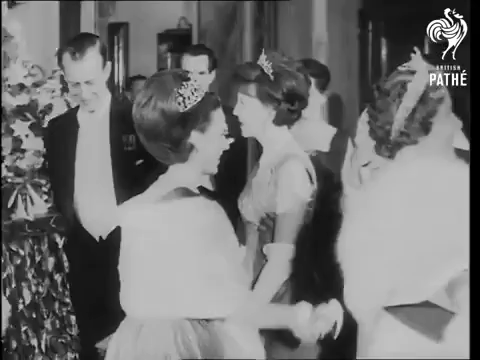
Also present was Princess Margaret, who sparkled in the Poltimore Tiara with a major beehive hairdo.
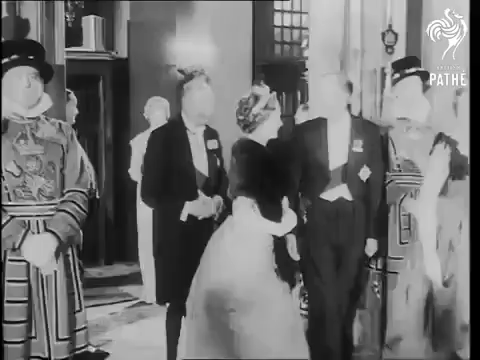
The Duchess of Gloucester wore Queen Mary’s Honeysuckle Tiara in its emerald setting.

And the Princess Royal sparkled in the all-diamond setting of her scroll tiara.

There’s one more little-seen member of the royal family pictured here behind the Queen Mum: the Marchioness of Cambridge. Lady Cambridge, who was born Dorothy Hastings, was married to Queen Mary’s nephew, George, the 2nd Marquess of Cambridge. Here, Dorothy is wearing the diamond star tiara that was given to her mother-in-law as a wedding present by Queen Mary and the Duke and Duchess of Teck in 1894.
The royal party was treated to a performance of the eighteenth-century comedic ballet La Fille Mal Gardée, which theater critic Philip Hope-Wallace noted was done by the resident ballet corps “with much style and spirit.” As the royals relaxed after their two-day sprint, however, troubling news came in from Brussels. The king and queen’s sister-in-law, Princess Paola, had been in a car accident in France while driving back from Paris. She’d suffered only minor injuries, but there was significant concern. Paola hadn’t yet announced it to the public, but she was three months pregnant with her third child, Prince Laurent. Thankfully, both she and the unborn prince were healthy after the crash.
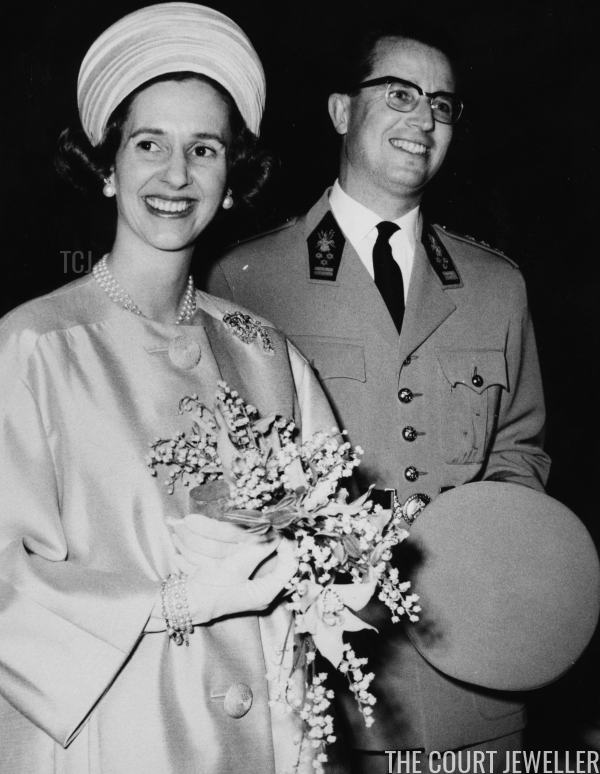 |
| Central Press/Getty Images |
The third day of the state visit — Thursday, May 16 — continued with more royal engagements and another gala. The couple split their time during the day, with King Baudouin traveling to the Royal Aircraft Establishment at Farnborough. Queen Fabiola, meanwhile, visited the National Gallery in London. The public was fascinated with the visiting Queen, predictably dubbing her “Fabulous Fabiola,” and the National Gallery visit was a prime example of the growing public interest. The Guardian reported that so many tourists and visitors crowded around the queen that “orders had to be given to cut down the number of people pressing around her.” Press photographers complained that tourists’ cameras were blocking them from doing their job, and gallery staff subsequently had to order visitors to stop taking pictures, too.
The royal couple reunited at Lancaster House in London, where they had tea with several British MPs and their wives. Queen Fabiola was presented with a bouquet of lily of the valley, and she told one woman present that she was “captivated by what she called their appealing beauty and their perfume.” One of the politicians in attendance commented that King Baudouin was very interested in hearing what it was like to be a British MP. The same man compared the king’s manner — “extremely brisk and alert” — to that of the Duke of Edinburgh.
 |
| AFP via Getty Images |
Another gala event capped off the third day of the state visit. King Baudouin and Queen Fabiola hosted a return dinner for the British royals at the Belgian Embassy in Eaton Square. For the occasion, Fabiola wore the aquamarine setting of the Spanish Wedding Gift Tiara, as well as other jewels from her aquamarine collection.
Here’s a look at Queen Fabiola’s jewels and gown in color for the dinner.
And one more, just for fun! This image shows Fabiola’s diamond and ruby bracelet rather clearly; such an interesting combination with the aquamarines.
Sadly, there isn’t a photo that I can share with you here of Queen Elizabeth’s ensemble for the banquet; you’ll have to click here to see an image of her attire. She wore the Girls of Great Britain and Ireland Tiara with jewels from the Brazilian Aquamarine Parure, accessorizing a very spangly Norman Hartnell gown. She secured the sash of the Order of Leopold with the Dorset Bow Brooch.
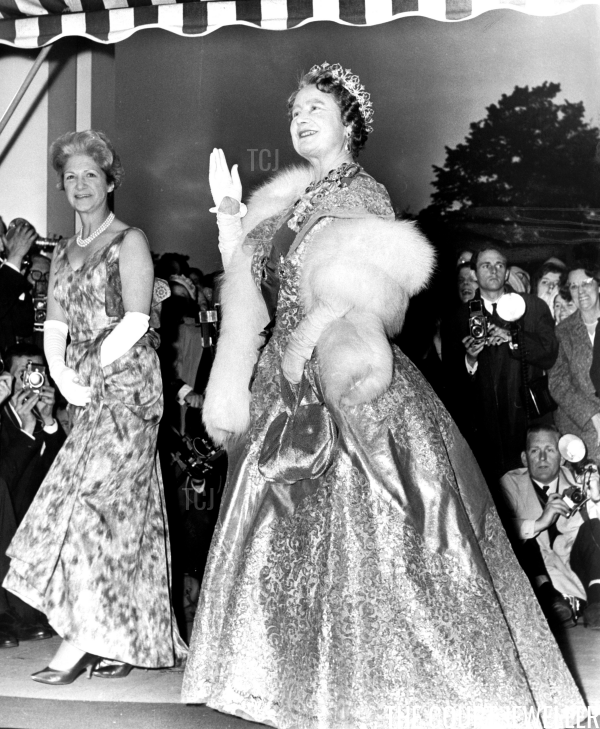 |
| Keystone Archives/Heritage Images/Print Collector/Alamy |
The Queen Mother was resplendent as usual in the Oriental Circlet and the Crown Rubies. Here’s a fun fact: she wore the same tiara in 1937 for the return dinner at the Belgian Embassy during King Leopold III’s state visit. Love a little royal continuity!
 |
| PA Images/Alamy |
Princess Margaret was elegant in the Persian Turquoises for the return dinner.
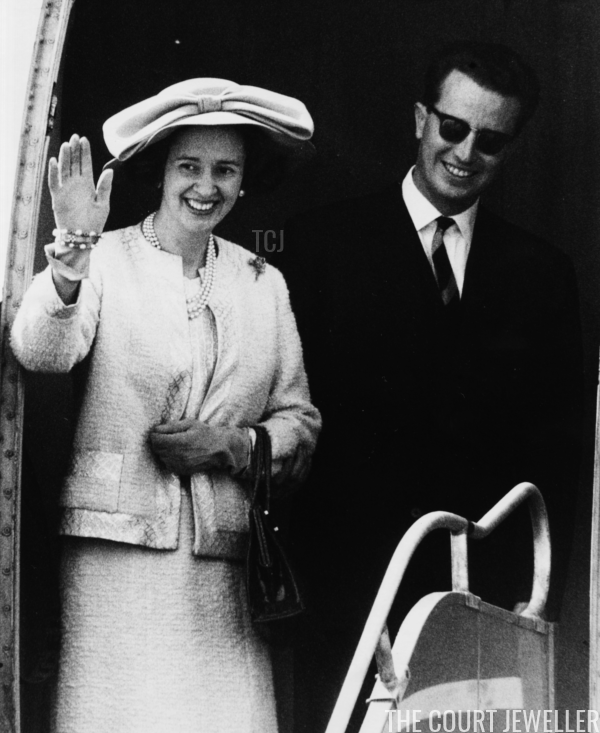 |
| Ted West/Central Press/Getty Images |
On Friday, May 17, the state visit came to an end. King Baudouin and Queen Fabiola boarded a plane to return to Brussels, accompanied by the Belgian Foreign Minister. He crowed that the royal couple had “conquered London.” In a more subdued message of thanks sent to the Queen, King Baudouin noted that he and his wife were “very moved by the cordial welcome of the British people and were confirmed in their conviction that the visit had further tightened the close links between Britain and Belgium.” She replied, agreeing that “the visit had drawn the two countries even closer together.”
Leave a Reply